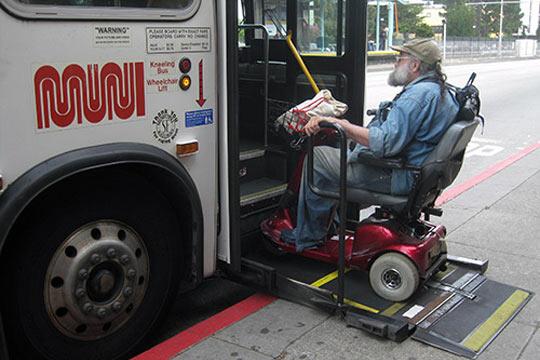
Clipper Access offers two eligibility pathways:
- Basic eligibility
- Medical eligibility
Review the Information Sheet for New Applicants (PDF) to determine which application is best for you.
- If you apply through Basic Eligibility, you may be required to renew your card periodically.
- If you apply through Medical Eligibility, you will need certification by a licensed medical professional. If you applied in January 2020 or later and your disability is certified as permanent, you will not need to renew your card.
Ready to apply?
Download the Basic Eligibility Application (PDF)
Download the Medical Eligibility Application (PDF)
Basic Eligibility Requirements
Download the Basic Eligibility Form (PDF)
Bring one of the following documents with you when you submit your application.
- Medicare card. The federally-issued red, white and blue card—only for those under 65 years of age. NOTE: Medi-Cal is not accepted for eligibility.
- California DMV Placard registration receipt. NOTE: Applicants with disabled license plates (DP) and no placard should apply through Medical Eligibility instead.
- ADA Paratransit. Provide the name of the Bay Area transit agency where eligibility was established.
- Other transit agency card from outside the Bay Area (within the United States). NOTE: It must be equivalent to Clipper Access or ADA Paratransit certification outside of a Bay Area transit agency.
- A copy of your VA Certification letter. NOTE: To prove veteran’s disability, this must demonstrate a disability rating for aid and attendance, or for a service-connected disability with a rating level of 50% or higher.
Transit agency staff will make a photocopy of your supporting documentation and submit it with your application. Staff will also take your photo for printing on the Clipper Access card.
Medical Eligibility Requirements
Download the Medical Eligibility Form (PDF)
If you apply for Medical Eligibility, you must have a California licensed professional certify your disability.
Application steps:
- Complete section 1 of the Medical Certification form.
- Sign the application in Sections 2 and 3: Your signature in Section 2 authorizes your doctor to release information, your signature in Section 3 is your acceptance of the Clipper Access program terms. If your application is not signed in the right places, it cannot be verified.
- Bring the Medical Certification form to your licensed professional. They will complete Section 4 of the form which certifies the disability.
- Bring the completed application form with you when you have your photo taken at your transit agency.
- It is recommended that you have the form completed before going to the transit agency to have your photo taken.
- If your doctor has not completed their portion of the form, the application verification process may take more than 21 days.
The licensed professionals listed below can complete Section Four of the Medical Eligibility Application. Licenses must be issued by the State of California.
- Licensed physicians with an M.D. or D.O. degree. Licensed physician's assistants and nurse practitioners may certify in all categories in which they are licensed to diagnose.
- Licensed chiropractors, categories 1, 2, 3 and 4.
- Licensed podiatrists, disabilities involving the feet under categories 1, 2, 3 and 4.
- Licensed optometrists (OPT), category 9.
- Licensed audiologists (AU), category 10.
- Licensed clinical psychologists (PSY) and licensed educational psychologists (LEP), categories 15, 16 and 17.
- Licensed marriage and family counselors (MFT), and licensed clinical social workers (LCSW), category 17.
The medical certifier's address and license information are required as part of the application. The certifier will be verified with the California Medical License Board and recorded in the Clipper Access database.
Medical Eligibility Categories
Category 1 - Non-ambulatory Disabilities
Impairments that, regardless of cause, require individuals to use a wheelchair for mobility.
Category 2 - Mobility Aids
Impairments that cause individuals to walk with significant difficulty including requiring use of a leg brace, cane, walker or crutches.
Category 3 - Musculo-Skeletal Impairment (Including Arthritis)
Musculo-skeletal impairment such as muscular dystrophy, osteogenesis imperfecta or arthritis of Functional Class III or anatomical Stage III. Individual has significant mobility impairment.
Category 4 - Amputation
Persons who suffer amputation of, or anatomical deformity of (i.e., loss of major function due to degenerative changes associated with vascular or neurological deficits, traumatic loss of muscle mass or tendons and x-ray evidence of bony or fibrous ankylosis at an unfavorable angle, joint subluxation or instability): (a) Both hands; or (b) one hand and one foot; or (c) amputation of lower extremity at or above the tarsal region (one or both legs).
Category 5 - Cerebrovascular Accident (Stroke)
With one of the following: (a) pseudobulbar palsy; or (b) functional motor deficit; or (c) ataxia affecting two extremities substantiated by appropriate cerebellar signs or proprioceptive loss post 4 months.
Category 6 - Pulmonary Ills
Respiratory impairments of Class 3 (FVC between 51 and 59% of predicted, or FEV between 41 and 59% of predicted); or Class 4 (FVC less than or equal to 50% of predicted, or FEV less than or equal to 40% of predicted.
Category 7 - Cardiac Ills
Cardiovascular impairments of functional Class III: Individuals with cardiac disease resulting in marked limitation of physical activity. They are comfortable at rest; less than ordinary physical activity causes fatigue, palpitation, dyspnea or anginal pain. (e.g., inability to walk one or more level blocks or climbing a flight of ordinary stairs.) Cardiovascular impairments of functional Class IV: Individuals with cardiac disease resulting in inability to carry out any physical activity without discomfort. Symptoms of cardiac insufficiency or of the anginal syndrome may be present even at rest. If physical activity is undertaken, discomfort is increased.
Category 8 - Dialysis
Individuals whose disability requires the use of a kidney dialysis machine.
Category 9 - Sight Disabilities
Those individuals whose vision in the better eye (after correction) is 20/200 or less; or those individuals whose visual field is contracted (tunnel vision) to 10° or less from point of fixation or widest diameter subtends an angle no greater than 20° and individuals who are unable to read information signs or symbols for other than language reasons.
Category 10 - Hearing Disabilities
Deafness or hearing incapacity that makes person unable to communicate or hear warning signals including those persons whose hearing loss is 70 dba or greater in the 500, 1000, 2000 Hz ranges.
Category 11 - Disabilities of Incoordination
Individuals suffering faulty coordination or palsy from brain spinal or peripheral nerve injury, functional motor deficit in any two limbs or manifestations which significantly reduce mobility, coordination or perceptiveness
Category 12 - Intellectual Disability
Intellectual Disability is a disorder that features concomitant deficits in intellectual functions and adaptive functioning that adversely impacts one or more aspects of daily living, such as communication, socialization, academic achievement and independent living. Significant delays in intellectual functions, which include reasoning, comprehension, judgment, problem solving, working memory and others, must be confirmed by standardized tests and clinical judgment. The significance of the disability, however, is determined by the extent of the limitations in adaptive functioning in the conceptual, social and practical domains. A deficit in adaptive functioning must be present in one or more of these domains and evidenced across multiple environments. The onset of these deficits must be seen during the developmental period and may be a result of a genetic syndrome, head trauma or acquired illness.
Category 13 - Cerebral Palsy
A neurological condition that appears in infancy or early childhood and permanently affects body movement, muscle coordination, and balance, and which primarily causes physical impairment involving limitation or loss of function and mobility. They experience difficulty with muscle coordination, muscle control, muscle tone, reflexes, balance or posture. They may have difficulty with fine or gross motor skills. Individuals with Cerebral Palsy may have associative and co-mitigating conditions that also impose additional challenges, such as a learning impairment, seizures, and vision or hearing loss.
Category 14 - Epilepsy (Convulsive Disorder)
A clinical disorder involving impairment of consciousness, characterized by seizures (e.g., generalized, complex partial, major motor, grand mal, petit mal or psychomotor), occurring more frequently than once a month in spite of prescribed treatment, with (a) diurnal episodes (loss of consciousness and convulsive seizure); (b) nocturnal episodes which show residual interfering with activity during the day; or (c) a disorder involving absence (petit mal) or mild partial (psychomotor) seizures occurring more frequently than once per week in spite of prescribed treatment with: 1) Alternation of awareness or loss of consciousness; and 2) Transient post-ictal manifestations of conventional or antisocial behavior. Persons exhibiting seizure-free control for a continuous period of more than six months duration are not included in the statement of Epilepsy defined in this section.
Category 15 - Autism Spectrum Disorder
Autism Spectrum Disorder is characterized by deficits in verbal and nonverbal communication abilities and social interaction skills, coupled with the presence of restricted, repetitive patterns of behavior, interest or activities, which significantly impact the quality of social, educational, occupational, and/or adaptive functioning. Symptoms typically manifest early in the developmental period, but may only become fully apparent with increased social expectations. The range and severity of symptoms can vary greatly, producing unique, individual profiles of strengths and needs. To qualify for discount fare eligibility, an individual must minimally demonstrate the need for a substantial level of support to address either social communication deficits or restricted, repetitive behaviors.
Category 16 - Neurological Impairment
A syndrome characterized by learning, perception and/or behavioral disorders of an individual whose IQ is not less than two standard deviations below the norm. These characteristics exist as a result of brain dysfunctions, neurologic disorder or any damage to the central nervous system, whether due to genetic, hereditary, accident or illness factors. This section includes persons with severe gait problems who are restricted in mobility.
Category 17 - Mental Disorders
Mental Disorders include a broad range of mental conditions that affect mood, thought, and behavior, and significantly impact one or more life activities. A DSM-5 diagnosis in one of the following categories is required for eligibility: Schizophrenia Spectrum and Other Psychotic Disorders, Bipolar and Related Disorders, Depressive Disorders, Trauma- and Stressor-Related Disorders, Dissociative Disorders, Somatic Symptoms and Related Disorders, and Neurocognitive Disorders. Please note that not all diagnoses within these categories will qualify for eligibility. For example, disorders in remission and "Unspecified" diagnoses are specifically excluded from discount fare eligibility. Additionally, applicants who have a Substance-Related or Addictive Disorder as a primary disability will not qualify for this program.
Category 18 - Chronic Progressive Debilitating Disorders
Individuals who experience chronic and progressive debilitating diseases that are characterized by constitutional symptoms such as fatigue, weakness, weight loss, pain and changes in mental status that, taken together, interfere in the activities of daily living and significantly impair mobility. Examples include: (a) Progressive, uncontrollable malignancies (i.e.. terminal malignancies or malignancies being treated with aggressive radiation or chemotherapy); (b) Advanced connective tissue diseases (i.e., advance states of disseminated lupus erythematosus, scleroderma or polyarteritis nodosa); (c) Symptomatic HIV infection (i.e., AIDS or ARC) in CDC-defined clinical categories B and C.
Category 19 - Multiple Impairments
This category may include, but not be limited to, persons disabled by the combined effects of more than one impairment. The individual impairments themselves may not be severe enough to qualify as a Transit Dysfunction; however, the combined effects of the disabilities may qualify the individual for the program.

